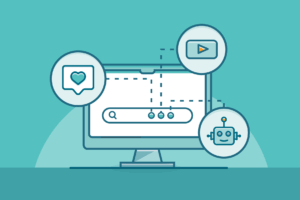
Website traffic is key to any online business as it leads to conversions, which ultimately provides leads or revenue.
But what if your website is getting little or no traffic? How can you identify what the problem is?
There are a number of reasons why this could be, from not knowing your target audience to not having an inbound marketing strategy. This five step guide will help you understand some of the key indicators that could be preventing users visiting your website and provide recommendations on how to increase traffic.
1. Target audience
Do you understand who your target audience is? Without knowing who you want to target, you won't be able to fully understand the reasons why your website isn’t getting any traffic (or increase your traffic), so this is a great place to start.
In short, your website won’t get any traffic if your target audience either doesn’t know that it will provide a solution to their needs or can’t find it when they are searching.
You need to identify who your target audience is, what their needs and concerns are and how your business provides a solution. You can do this by using buyer personas.
Start with research - this process can be as comprehensive as you like from using your existing customer database to lead capture forms and analytics data. You need to look at who your customers are, where they are coming from and why they need your products/services.
You can use one of our buyer persona templates (both B2B and B2C), available in our comprehensive buyer persona guide, to start identifying who your buyer personas are.
Once you’ve used your research to create your buyer persona, as well as the different lifecycle stages your prospects go through in the buyer’s journey, you will be able to adapt your website to suit their needs following the next four steps and drive more traffic, conversions and ultimately sales.
2. Brand awareness
Brand awareness is another reason why your website may be getting no traffic. If your target audience isn’t aware that your product or service exists then they won’t associate your brand with being a solution to their problem. To improve this you can implement inbound marketing tactics.
Inbound marketing attracts qualified prospects to your website with the aim of turning them into leads or customers. To effectively implement inbound marketing in your business you need to consider all elements of the decision-making process and use the right channels for your target audience.
Each stage of the inbound marketing methodology requires something different from inbound marketing.
Currently you want to improve brand awareness and drive traffic. In the awareness stage you need to use appropriate channels to provide relevant information to attract potential leads to your website. You can do this through creating relevant content, improving SEO, leveraging social media and even creating a Google Ads campaign if your budget allows.
To take your lead to the next stage of the buyer’s journey once they’re on your website, you need to encourage your visitors to engage with your brand through channels including chatbots, calls to action and forms.
Using emails, workflows and your CRM integration (if available) you will be able to nurture these leads to make them into customers, before asking them to fill in surveys and feedback on Google My Business or social channels, leading them to promote your site and attract new visitors.
3. Keywords
Keywords not only play a key role in your site’s ability to rank well, they are a key traffic driver as they connect what your audience is searching for to your website content. What keywords are you trying to rank for through your current content? Do they fit what your target audience is searching for?
If your current keywords are very popular, this could be a contributing factor in your lack of traffic as popular keywords are harder to rank for. Equally, if the search volume is too low, you are also running the risk of driving no traffic to your website.
Using a keyword ranking tool such as Moz’s keyword explorer you can begin with your seed keywords - the terms you expect your audience to be searching for. A keyword tool will provide you with the search volume and how difficult it is to rank for each keyword. You will then be able to discover other similar keywords related to your search term that are also popular.
Take a look at the long-tail keywords that your audience is searching frequently for and optimise for them. These are more specific search terms that have intent behind them - e.g. rather than searching for ‘digital marketing agency’ you might search for ‘digital marketing agency milton keynes’.
To drive more traffic, you want to try and rank for seed keywords with low competition and long-tail keywords with high volume. Why not take a look at Moz’s beginner’s guide to keyword research to learn more.
4. Technical on-page optimisation
On-page SEO is key to driving traffic to your website. On-page SEO consists of technical elements such as page titles, meta descriptions, alt tags and URIs as well as the on-page content of a page. All of these elements should reflect the chosen keywords for each page.
Firstly, check that all of the technical elements above are correct for your key pages.
For example it is very clear in Aira’s page title in the below search result what the company does and where we’re based.
Secondly the meta description has been altered so it doesn’t just pull from the page content to include the keywords of Milton Keynes, digital marketing as well as a range of services that are offered that a user may also search for along with these terms.

5. Content
Irrelevant on-page content may also be limiting your website’s traffic. You need to ensure the content on each page of your website is relevant to the user intent of the search term. This will link your keywords, your technical on-page optimisation and content together. If your landing page content isn’t relevant then the user will exit your site quickly, leading to a high bounce rate.
Here are our top tips to ensure your content is relevant:
- Make sure your content is detailed
- Think about page structure - use H1s and H2s to organise your content clearly
- Don’t duplicate content from elsewhere on your website
- Ensure your keywords are woven into your content
- Consider who your target audience for this page is and where in the buyer’s journey they are
If you have a blog, you also need to consider the content strategy behind this. Your blog should produce content that will attract users to your website, be informative and help your potential customers in their decision-making process.
Your blog should showcase that you are an expert in the products or services you provide, providing trustworthy and authoritative content. Your content strategy will help you target a specific stage in your buyer’s journey and provide relevant content to help provide a solution.






